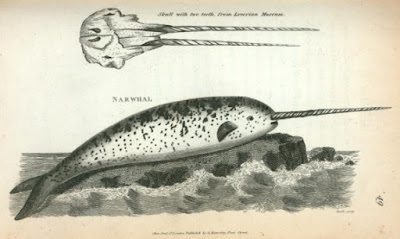Looking for Narwhals in all the Noisy Places
Narwhals are medium-sized whales, sometimes called "unicorns of the sea". That is because of the long tusk (not a horn) that protrudes. They are found in Arctic areas including Canada and Greenland, but are a mite difficult to study. A new research technique produced some interesting results.
Those Arctic waters are noisy in the first place because of ice cracking and other things. Interesting that narwhals are skittish around the noise of boats with motors. With the assistance of some Inuit people, researchers were able to do some underwater recording anyway. They make a racket all their own.
Not only are they communicating with each other, they have echolocation. Narwhals have baffled evolutionists with their ability to hybridize with beluga whales, and they were clearly designed by our Creator to be able to adapt for life in their unique areas.
This short video is interesting, but sound is not needed.
 |
| Since I have been unable to find an image that is not copyrighted, here is an illustration from 1809 by George Shaw. |
Not only are they communicating with each other, they have echolocation. Narwhals have baffled evolutionists with their ability to hybridize with beluga whales, and they were clearly designed by our Creator to be able to adapt for life in their unique areas.
Recently, after audio-recording underwater in Greenland’s fjords, two geoscientists published research on vocalizations made by narwhals. The sounds included shrill whistle tones, repetitive clicks, knocking sounds, buzzing noises, and even some tonal pulses inaudible to human ears. Complicating the situation, narwhals routinely summer near calving icebergs, so their natural surroundings are often noisy.The article linked here did not indicate if the researchers did homage to Darwin, which would have detracted from their impressive work. To read this article in its entirety, click on "Noisy Narwhals in Greenland’s Frigid Fjords". For related material, see "The Mysterious Narwhal".
. . .
Narwhals (also spelled “narwhales”) habitually summer underwater in the frigid glacial fjords of Northwest Greenland’s coastal ocean-waters, and other waters blend into the Arctic Ocean. But because these marine mammals shy away from motor-driven boats, they have not been well studied by modern Arctic Ocean ecologists.
. . .
However, this narwhal shyness has been circumvented by two geophysicists, Dr. Evgeny Podolskiy and Dr. Shin Sugiyama, whose research focus in cold climates. Their most recent research on narwhal noises is unprecedented. It provides a starting point for documenting different noises narwhals make as social communications. The research also investigates how narwhals use sound to echolocate underwater to find prey, such as fish, squid, and shrimp, and physical structures such as icebergs.
This short video is interesting, but sound is not needed.